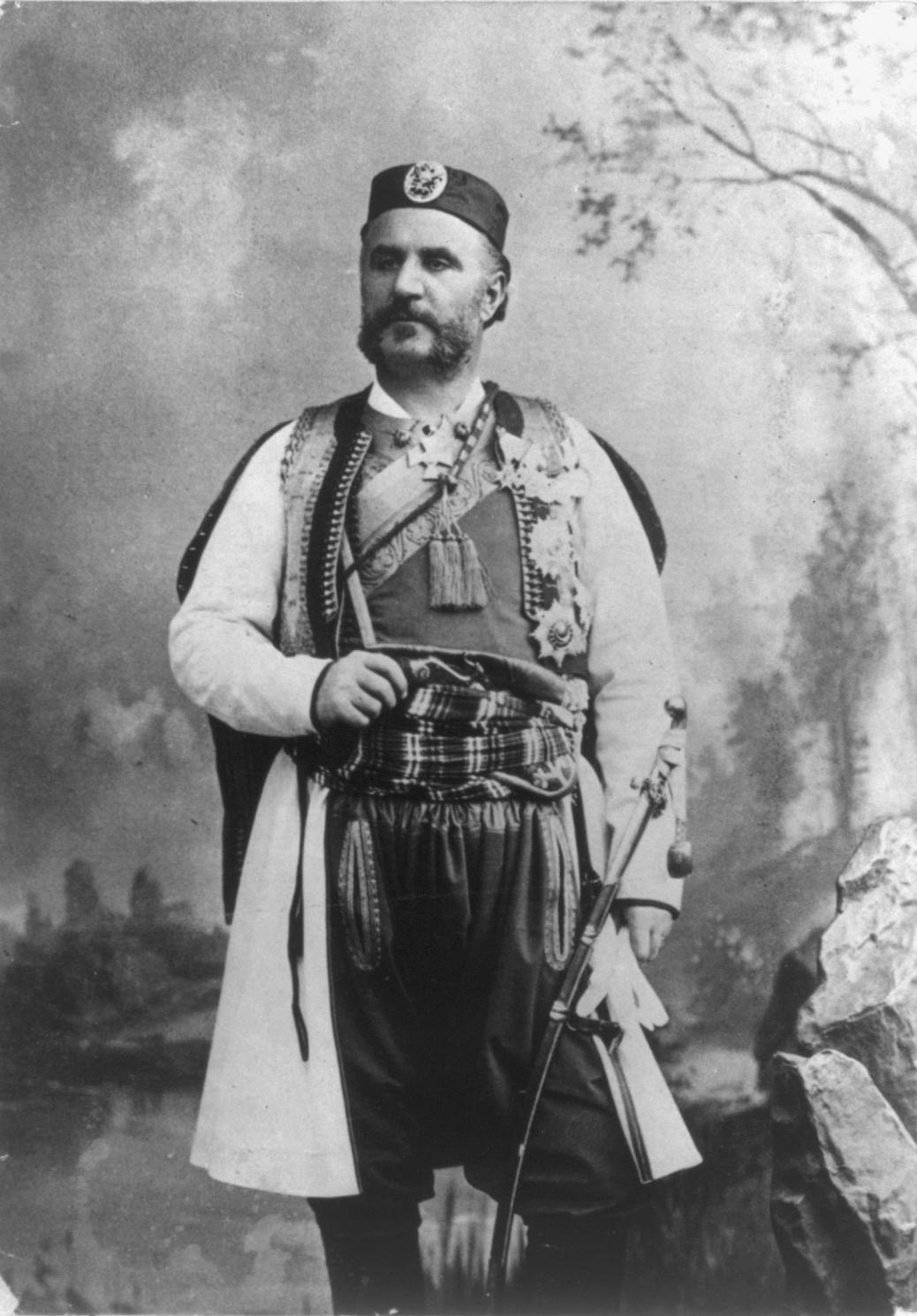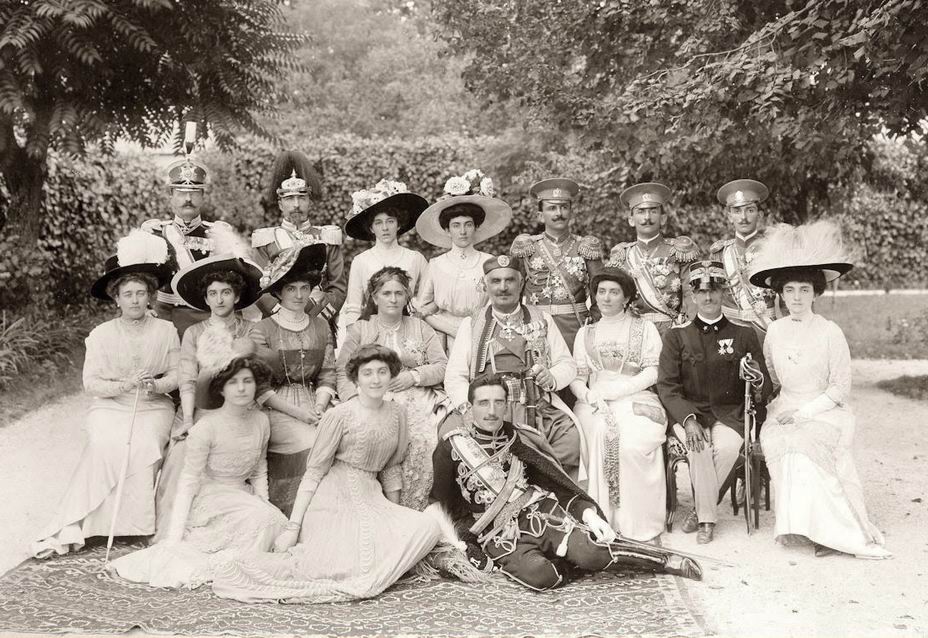|
Sergei Georgievich, 8th Duke Of Leuchtenberg
Prince Sergei Georgievich Romanowsky, 8th Duke of Leuchtenberg (4 July 1890 – 7 January 1974) was the son of Prince George Maximilianovich Romanowsky, 6th Duke of Leuchtenberg and his second wife Princess Anastasia of Montenegro. He succeeded his half-brother Alexander Georgievich as Duke of Leuchtenberg from 1942 until his death. Background and early life Prince Sergei was born on 4 July 1890 in Peterhof, Russian Empire to George Maximilianovich, 6th Duke of Leuchtenberg and Princess Anastasia of Montenegro. Sergei was styled ''His Serene Highness'' from birth until 1899 when he was granted the style of ''His Highness''. George's first wife, Duchess Therese Petrovna of Oldenburg, died in 1883, leaving a young son. Sergei's father remarried six years later, when he caught the attention of Princess Anastasia of Montenegro at her sister Milica's wedding. George and Anastasia soon married and produced two children, Sergei and Elena. Anastasia divorced her husband in 1906 in order ... [...More Info...] [...Related Items...] OR: [Wikipedia] [Google] [Baidu] |
Duke Of Leuchtenberg
Duke of Leuchtenberg was a title created twice by List of rulers of Bavaria, the monarchs of Bavaria for their relatives. The first creation was awarded by Maximilian I, Elector of Bavaria to his son Maximilian Philipp Hieronymus, upon whose death without children the lands passed back to his nephew Maximilian II, Elector of Bavaria, Elector Maximilian II. It was re-created by Maximilian I Joseph of Bavaria, Maximilian I Joseph, King of Bavaria on 14 November 1817 and awarded to his son-in-law, Eugène de Beauharnais, styled ''Royal Highness'' by personal grant, and with the style ''Serene Highness'' for his Patrilineality, agnatic descendants. Eugène was the adopted stepson of the deposed Emperor Napoleon, Napoleon I of France, and had previously held the title of French prince (''Prince français'') with the style ''Imperial Highness.'' He also had been the emperor's heir in Grand Duchy of Frankfurt, Frankfurt and briefly in Kingdom of Italy (Napoleonic), Italy. King Maximilian J ... [...More Info...] [...Related Items...] OR: [Wikipedia] [Google] [Baidu] |
RUS Order Of St
Rus or RUS may refer to: People and places * Rus (surname), a Romanian-language surname * East Slavic historical territories and peoples (). See Names of Rus', Russia and Ruthenia ** Rus' people, the people of Rus' ** Rus' territories *** Kievan Rus', a medieval East Slavic state, centered in Kiev *** Rus' Khaganate, a ninth-century Eastern European state *** Ruthenia *** Vladimir-Suzdal (Vladimirian Rus'), an East Slavic medieval state, centered in Vladimir *** Principality of Halych (Halychian Rus'), an East Slavic medieval state, in region of Halych *** Principality of Volhynia (Volhynian Rus'), an East Slavic medieval state, in regions of Volhynia *** Kingdom of Galicia–Volhynia (Halych-Volhynian Rus'), an East Slavic medieval state, uniting Halych and Volhynia ***Kingdom of Rus', an East Slavic medieval kingdom (Galicia-Volhynia) *** Principality of Turov (Turovian Rus'), an East Slavic medieval state, in region of Turov *** Principality of Polotsk (Polotskian Rus'), an East ... [...More Info...] [...Related Items...] OR: [Wikipedia] [Google] [Baidu] |
Nicholas I Of Montenegro
Nikola I Petrović-Njegoš ( sr-cyr, Никола I Петровић-Његош; – 1 March 1921) was the last monarch of Montenegro from 1860 to 1918, reigning as prince from 1860 to 1910 and as the country's first and only king from 1910 to 1918. Biography Early life Nikola was born in the village of Njeguši, the home of the reigning House of Petrović. He was the son of Mirko Petrović-Njegoš, a celebrated Montenegrin warrior (an elder brother to Danilo I of Montenegro) and his wife, Anastasija Martinovich (1824–1895). After 1696, when the dignity of vladika, or prince-bishop, became hereditary in the Petrović family, the sovereign power had descended from uncle to nephew, the vladikas belonging to the order of the black clergy (i.e., monastic clergy) who are forbidden to marry. A change was introduced by Danilo I, who declined the episcopal office, married and declared the principality hereditary in the direct male line. Mirko Petrović-Njegoš having renounced his cla ... [...More Info...] [...Related Items...] OR: [Wikipedia] [Google] [Baidu] |
Grand Duchess Maria Nikolaevna Of Russia (1819–1876)
Grand Duchess Maria Nikolaievna of Russia (russian: Мария Николаевна) (18 August 1819 – 21 February 1876) was a daughter of Emperor Nicholas I of Russia, and sister of Alexander II. In 1839 she married Maximilian, Duke of Leuchtenberg. She was an art collector and President of the Imperial Academy of Arts in Saint Petersburg. Early life Grand Duchess Maria Nikolaievna was born on in Krasnoye Selo in Saint Petersburg. She was the second of seven surviving children and the eldest daughter.Belyakova, '' Grand Duchess Maria Nikolayevna and her palace in St Peterburg '', p. 17 Her parents, Tsar Nicholas I of Russia and Empress Alexandra Feodorovna, born Princess Charlotte of Prussia, were devoted to each other and to their children. They were warm and affectionate parents, but avoided overindulging them. In the evenings, Alexandra Feodorovna played games with her children, including riddles and charades.Belyakova, '' Grand Duchess Maria Nikolayevna and her palac ... [...More Info...] [...Related Items...] OR: [Wikipedia] [Google] [Baidu] |
Maximilian De Beauharnais, 3rd Duke Of Leuchtenberg
Maximilian Joseph Eugene Auguste Napoleon de Beauharnais, 3rd Duke of Leuchtenberg, Prince Romanowsky (2 October 1817 – 1 November 1852) was the husband of Grand Duchess Maria Nikolayevna of Russia and first cousin of Emperors Napoleon III of the French and Francis Joseph I of Austria. He was a grandson of Napoleon I's first wife, the Empress Josephine, by her prior marriage to Alexandre de Beauharnais. A student of Moritz von Jacobi, he is known as one of pioneers in galvanoplasty and an expert in copper and bronze metalworks generally, as well as an art collector. Childhood He was born as the second son of Eugène de Beauharnais, Duke of Leuchtenberg and Prince of Eichstätt and Princess Augusta Amalia Ludovika Georgia of Bavaria. His maternal grandparents were Maximilian I, King of Bavaria and his first wife Marie Wilhelmine Auguste, Landgravine of Hesse-Darmstadt. His maternal grandmother Marie Wilhelmine Auguste was a daughter of Georg Wilhelm of Hesse-Darmstadt, you ... [...More Info...] [...Related Items...] OR: [Wikipedia] [Google] [Baidu] |
King Nicholas I Of Montenegro
Nikola I Petrović-Njegoš ( sr-cyr, Никола I Петровић-Његош; – 1 March 1921) was the last monarch of Montenegro from 1860 to 1918, reigning as prince from 1860 to 1910 and as the country's first and only king from 1910 to 1918. Biography Early life Nikola was born in the village of Njeguši, the home of the reigning House of Petrović. He was the son of Mirko Petrović-Njegoš, a celebrated Montenegrin warrior (an elder brother to Danilo I of Montenegro) and his wife, Anastasija Martinovich (1824–1895). After 1696, when the dignity of vladika, or prince-bishop, became hereditary in the Petrović family, the sovereign power had descended from uncle to nephew, the vladikas belonging to the order of the black clergy (i.e., monastic clergy) who are forbidden to marry. A change was introduced by Danilo I, who declined the episcopal office, married and declared the principality hereditary in the direct male line. Mirko Petrović-Njegoš having renounced his cla ... [...More Info...] [...Related Items...] OR: [Wikipedia] [Google] [Baidu] |
Order Of Danilo I
The Order of Prince Danilo I ( cnr, Орден Књаза Данила I, translit=Orden Knjaza Danila I) was an order of the Principality and later Kingdom, of Montenegro. It is currently a dynastic order granted by the head of the House of Petrović-Njegoš, Crown Prince Nicholas. It is awarded to prominent champions of the preservation of Montenegrin independence and for other humanitarian, scientific, artistic and pro-social achievements as defined by statute. Alterations were made to the appearance of the original decoration created by Prince Danilo, and during the rule of King Nikola I Petrović Njegoš the Order underwent two restructurings. During the first restructuring in 1861, three classes were introduced, while in the second restructuring, in 1873, an additional fourth class was added, so that not only is there a star in the 1st class but also a 2nd class with star was introduced. By 1922, the order consisted of five classes: Knight Grand Cross, Knight Grand Offi ... [...More Info...] [...Related Items...] OR: [Wikipedia] [Google] [Baidu] |
Order Of Saint Vladimir, Ribbon Bar
Order, ORDER or Orders may refer to: * Categorization, the process in which ideas and objects are recognized, differentiated, and understood * Heterarchy, a system of organization wherein the elements have the potential to be ranked a number of different ways * Hierarchy, an arrangement of items that are represented as being "above", "below", or "at the same level as" one another * an action or inaction that must be obeyed, mandated by someone in authority People * Orders (surname) Arts, entertainment, and media * ''Order'' (album), a 2009 album by Maroon * "Order", a 2016 song from ''Brand New Maid'' by Band-Maid * ''Orders'' (1974 film), a 1974 film by Michel Brault * ''Orders'', a 2010 film by Brian Christopher * ''Orders'', a 2017 film by Eric Marsh and Andrew Stasiulis * ''Jed & Order'', a 2022 film by Jedman Business * Blanket order, purchase order to allow multiple delivery dates over a period of time * Money order or postal order, a financial instrument usually int ... [...More Info...] [...Related Items...] OR: [Wikipedia] [Google] [Baidu] |
Order Of Saint Stanislaus (House Of Romanov)
pl, Order św. Stanisława , image = , caption = , image2 = , caption2 = Ribbon of the order , awarded_by = Head of the House of Romanov , type = Dynastic order of knighthood , motto = Praemiando incitat("Rewarding encourages") , day = , eligibility = , for = Military and civil merits , status = active , head_title = Sovereign , head = , head2_title = , head2 = , chancellor = , commander = , grades = Knight Grand CrossKnight CommanderKnight , former_grades = , date = 1831 – 1918 (National Order)1918 - Present (house order) , house = House of Romanov , religion = Russian Orthodox , higher = Order of Saint Anastasia , lower = Order of Saint Michael the Archangel , ribbon = Bright red with a white stripe on either side and a thinner white stripe on the end of either stri ... [...More Info...] [...Related Items...] OR: [Wikipedia] [Google] [Baidu] |
RUS Order św
Rus or RUS may refer to: People and places * Rus (surname), a Romanian-language surname * East Slavic historical territories and peoples (). See Names of Rus', Russia and Ruthenia ** Rus' people, the people of Rus' ** Rus' territories *** Kievan Rus', a medieval East Slavic state, centered in Kiev *** Rus' Khaganate, a ninth-century Eastern European state *** Ruthenia *** Vladimir-Suzdal (Vladimirian Rus'), an East Slavic medieval state, centered in Vladimir *** Principality of Halych (Halychian Rus'), an East Slavic medieval state, in region of Halych *** Principality of Volhynia (Volhynian Rus'), an East Slavic medieval state, in regions of Volhynia *** Kingdom of Galicia–Volhynia (Halych-Volhynian Rus'), an East Slavic medieval state, uniting Halych and Volhynia ***Kingdom of Rus', an East Slavic medieval kingdom (Galicia-Volhynia) *** Principality of Turov (Turovian Rus'), an East Slavic medieval state, in region of Turov *** Principality of Polotsk (Polotskian Rus'), an Ea ... [...More Info...] [...Related Items...] OR: [Wikipedia] [Google] [Baidu] |



